|
Notice: This page contains information for the legacy Phidget21 Library. Phidget21 is out of support. Bugfixes may be considered on a case by case basis. Phidget21 does not support VINT Phidgets, or new USB Phidgets released after 2020. We maintain a selection of legacy devices for sale that are supported in Phidget21. We recommend that new projects be developed against the Phidget22 Library.
|
Language - LabVIEW: Difference between revisions
No edit summary |
No edit summary |
||
| Line 2: | Line 2: | ||
[[File:icon-LabVIEW.png|64x64px]] Preamble about the language's origin and its main characteristics. | [[File:icon-LabVIEW.png|64x64px]] Preamble about the language's origin and its main characteristics. | ||
== | [[Category:Language]] | ||
LabVIEW | [[File:icon-LabVIEW.png|64x64px|link=|alt=LabVIEW]] LabVIEW ..., developed by [http://www.ni.com National Instruments] is a ... | ||
__TOC__ | |||
==Introduction== | |||
{{LanguageSupport|LabVIEW|the complete Phidget API, including events|all Phidget devices.| the Microsoft Visual Basic 6 IDE|}} | |||
==Quick Downloads== | |||
{{QuickDownloads|Visual Basic 6.0| | |||
{{APIQuickDownloads|http://www.phidgets.com/documentation/COM_API_Manual.pdf COM}}| | |||
{{ExampleQuickDownloads|http://www.phidgets.com/downloads/examples/VB6_2.1.8.20120131.zip|}}| | |||
{{WindowsQuickDownloads}} | |||
}} | |||
==Getting started with LabVIEW== | |||
If you are new to writing code for Phidgets, we recommend starting by running, then modifying existing examples. This will allow you to: | |||
{{ExampleCodeReasons}} | |||
==Windows(2000/XP/Vista/7)== | |||
===Description of Library Files=== | |||
LabVIEW programs on Windows depend on two files, which the installers in [[#Libraries and Drivers|Quick Downloads]] put onto your system: | |||
* <b>{{Code|phidget21.dll}}</b> contains the actual Phidget library, which is used at run-time. By default, it is placed in {{Code|C:\Windows\System32}}. | |||
* <b>{{Code|Phidget21COM.dll}}</b> is the Component Object Model(COM) library and provides your project access to the Phidget ActiveX objects. Your compiler has to know where this file is, by default our installer places this file into {{Code|C:\Program Files\Phidgets}}, so you can either point your compiler to that location, or copy and link to it in a directory for your project workspace. | |||
If you do not want to use our installer, you can download both [http://www.phidgets.com/downloads/libraries/phidget21-x86_2.1.8.20110615.zip files] and manually install them where you want; refer to our [[Manual Installation Instructions | Manual Installation Instructions]]. | |||
We include instructions on [[#Use Our Examples | using our examples]] and [[#Write Your Own Code | writing your own code]] for the Microsoft Visual Basic 6.0 IDE. | |||
====LabVIEW==== | |||
=====Use Our Examples===== | |||
To run the examples, you first download the [http://www.phidgets.com/downloads/examples/VB6_2.1.8.20120131.zip examples] and unpack them into a folder. Here, you can find example programs for all the devices. If you aren't sure what the software example for your device is called, check the software object listed in the [[Device List | Getting Started guide for your device]]. | |||
1. Open up the {{Code|.vbp}} project into the Visual Basic IDE. | |||
2. Next, navigate to Project → Components to ensure that your project has access to the Phidget ActiveX objects | |||
[[File:VB6 Components.PNG|link=|alt=Components]] | |||
3. The Components menu will show up. Ensure that the Phidget COM library is selected. If it is not, then browse for {{Code|Phidget21COM.dll}} and add it. By default, it is placed in {{Code|C:\Program Files\Phidgets}}. Accept the changes. | |||
[[File:VB6 Library.PNG|link=|alt=Library]] | |||
4. Navigate to Project → References and ensure that the Phidget COM library is selected. | |||
[[File:VB6 References.PNG|link=|alt=References]] | |||
5. The only thing left to do is to run the examples! Click on Run → Start. | |||
[[File:VB6 Run.PNG|link=|alt=Run]] | |||
Once you have the Visual Basic 6.0 examples running, we have a [[#Follow the Examples|teaching]] section below to help you follow them. | |||
=====Write Your Own Code===== | |||
When you are building a project from scratch, or adding Phidget function calls to an existing project, you'll need to configure your development environment to properly link the Phidget COM library. To begin: | |||
1. Generate a new Standard EXE project. | |||
[[File:VB6 New Project.PNG|link=|alt=New Project]] | |||
2. Next, navigate to Project → Components to add the Phidget ActiveX objects into your project. | |||
[[File:VB6 Components.PNG|link=|alt=Components]] | |||
3. The Components menu will show up. Browse for {{Code|Phidget21COM.dll}} and add it. By default, it is placed in {{Code|C:\Program Files\Phidgets}}. Accept the changes. | |||
[[File:VB6 Library.PNG|link=|alt=Library]] | |||
4. Navigate to Project → References and ensure that the Phidget COM library is selected. | |||
[[File:VB6 References.PNG|link=|alt=References]] | |||
5. Navigate to Project → Project1 Properties, select the {{Code|Make}} tab and ensure that the {{Code|Remove information about unused ActiveX Controls}} checkbox is unchecked. | |||
[[File:VB6 Unused ActiveX Controls.PNG|link=|alt=Unused ActiveX Controls]] | |||
6. Then, you will need to declare and initialize the Phidget ActiveX object for your device. | |||
The simplest method is to place the Phidget ActiveX object from the toolbox directly onto your form. If the toolbox is not present on your screen, navigate to View → Toolbox to show the toolbar. Next, find the ActiveX object for your device in the toolbox, and double click it to add it to the form. | |||
[[File:VB6 Toolbox ActiveX.PNG|link=|alt=Accessing Phidget ActiveX objects from the toolbox]] | |||
Alternatively, you can dynamically create the Phidget ActiveX object in code. For example, for an PhidgetInterfaceKit, you would type: | |||
<div class="source"> | |||
<syntaxhighlight lang=vb> | |||
Dim WithEvents PhidgetInterfaceKit As PhidgetInterfaceKit | |||
Private Sub Form_Load() | |||
... | |||
Set PhidgetInterfaceKit = Controls.Add("Phidget21COM.PhidgetInterfaceKit", "PhidgetInterfaceKit") | |||
... | |||
End Sub | |||
</syntaxhighlight> | |||
</div> | |||
The object name for each type of Phidget is listed in the [http://www.phidgets.com/documentation/COM_API_Manual.pdf COM API Manual]. Please see the [http://www.phidgets.com/downloads/examples/VB6_2.1.8.20120131.zip examples] on how to add a reference to your particular Phidget. | |||
The project now has access to the Phidget function calls and you are ready to begin coding. | |||
The same [[#Follow the Examples|teaching]] section which describes the examples also has further resources for programming your Phidget. | |||
==Follow the Examples== | |||
By following the instructions for your operating system and compiler above, you probably now have a working example and want to understand it better so you can change it to do what you want. This teaching section has resources for you to learn from the examples and write your own. | |||
Next comes our API information, with syntax for all of our functions: | |||
{{UsingAPhidgetInCodeGeneral|both of which are available in Visual Basic 6.0|[http://www.phidgets.com/documentation/COM_API_Manual.pdf COM API Manual]}} | |||
== | ===Example Flow=== | ||
{{ExamplePseudocode|In Visual Basic 6.0, you can name these '''event''' functions whatever you like. You will then pass them as function pointers to the Phidget library below in the Main Code section. This hooks them into the actual events when they occur. <br> | |||
In the example code, the event functions common to all Phidgets are called things like '''AttachHandler()''' and '''DetachHandler()''', etc.<br><br> | |||
Some event functions will be specific to each device, like when a tag is read on an RFID board, or when a sensor value changes on an Interface Kit. | |||
Other functions are given in the examples to show you more detail on using your Phidget. For example, '''DeviceInitialize()''' will show what needs to be set up for your Phidget before using it. | |||
|Creating a Phidget software object in Visual Basic 6.0 is specific to the Phidget. For a Phidget Spatial, for example, this would involve creating a PhidgetSpatial object. The examples show how to do this and other API functions| | |||
[http://www.phidgets.com/documentation/COM_API_Manual.pdf COM API Manual]}} | |||
==Common Problems and Solutions/Workarounds== | ==Common Problems and Solutions/Workarounds== | ||
{{KnownIssues|Phidgets do not always work cleanly in Labview. Sometimes they do not appear, sometimes they work veeerrryyy slowly. No known fixes yet, hopefully soon.}} | {{KnownIssues|Phidgets do not always work cleanly in Labview. Sometimes they do not appear, sometimes they work veeerrryyy slowly. No known fixes yet, hopefully soon.}} | ||
Revision as of 18:17, 19 March 2012
![]() Preamble about the language's origin and its main characteristics.
Preamble about the language's origin and its main characteristics.
![]() LabVIEW ..., developed by National Instruments is a ...
LabVIEW ..., developed by National Instruments is a ...
Introduction
If this is your first time working with a Phidget, we suggest starting with the Getting Started page for your specific device. This can be found in the user guide for your device. That page will walk you through installing drivers and libraries for your operating system, and will then bring you back here to use LabVIEW specifically.
LabVIEW is capable of using the complete Phidget API, including events. We also provide example code in LabVIEW for all Phidget devices.
LabVIEW can be developed with the Microsoft Visual Basic 6 IDE.
You can compare LabVIEW with our other supported languages.
Quick Downloads
Just need the Visual Basic 6.0 documentation, drivers, libraries, and examples? Here they are:
Documentation
Example Code
Libraries and Drivers
- 32-bit Windows Drivers Installer
- 64-bit Windows Drivers Installer
- Windows Driver and Library Files (Zipped)
Getting started with LabVIEW
If you are new to writing code for Phidgets, we recommend starting by running, then modifying existing examples. This will allow you to:
- Make sure your libraries are properly linked
- Go from source code to a test application as quickly as possible
- Ensure your Phidget is hooked up properly
Windows(2000/XP/Vista/7)
Description of Library Files
LabVIEW programs on Windows depend on two files, which the installers in Quick Downloads put onto your system:
phidget21.dllcontains the actual Phidget library, which is used at run-time. By default, it is placed inC:\Windows\System32.Phidget21COM.dllis the Component Object Model(COM) library and provides your project access to the Phidget ActiveX objects. Your compiler has to know where this file is, by default our installer places this file intoC:\Program Files\Phidgets, so you can either point your compiler to that location, or copy and link to it in a directory for your project workspace.
If you do not want to use our installer, you can download both files and manually install them where you want; refer to our Manual Installation Instructions.
We include instructions on using our examples and writing your own code for the Microsoft Visual Basic 6.0 IDE.
LabVIEW
Use Our Examples
To run the examples, you first download the examples and unpack them into a folder. Here, you can find example programs for all the devices. If you aren't sure what the software example for your device is called, check the software object listed in the Getting Started guide for your device.
1. Open up the .vbp project into the Visual Basic IDE.
2. Next, navigate to Project → Components to ensure that your project has access to the Phidget ActiveX objects
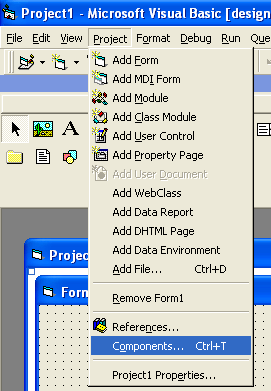
3. The Components menu will show up. Ensure that the Phidget COM library is selected. If it is not, then browse for Phidget21COM.dll and add it. By default, it is placed in C:\Program Files\Phidgets. Accept the changes.
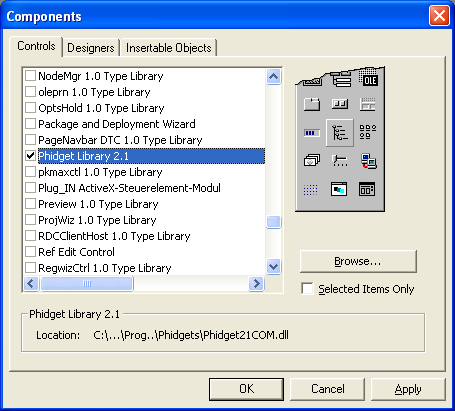
4. Navigate to Project → References and ensure that the Phidget COM library is selected.
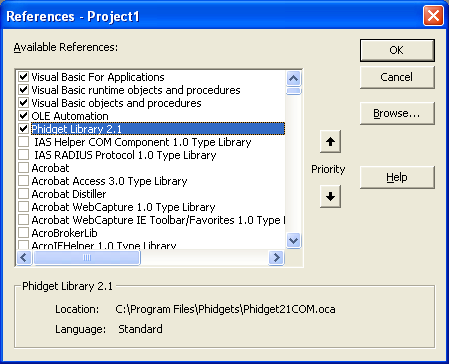
5. The only thing left to do is to run the examples! Click on Run → Start.

Once you have the Visual Basic 6.0 examples running, we have a teaching section below to help you follow them.
Write Your Own Code
When you are building a project from scratch, or adding Phidget function calls to an existing project, you'll need to configure your development environment to properly link the Phidget COM library. To begin:
1. Generate a new Standard EXE project.
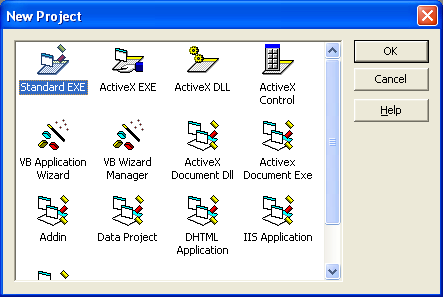
2. Next, navigate to Project → Components to add the Phidget ActiveX objects into your project.

3. The Components menu will show up. Browse for Phidget21COM.dll and add it. By default, it is placed in C:\Program Files\Phidgets. Accept the changes.

4. Navigate to Project → References and ensure that the Phidget COM library is selected.

5. Navigate to Project → Project1 Properties, select the Make tab and ensure that the Remove information about unused ActiveX Controls checkbox is unchecked.
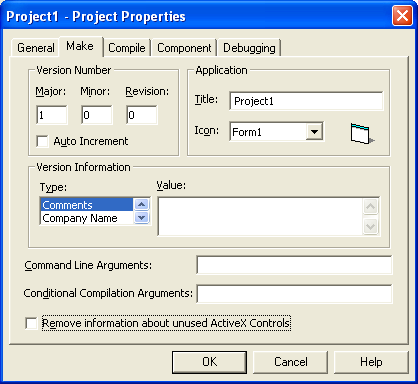
6. Then, you will need to declare and initialize the Phidget ActiveX object for your device.
The simplest method is to place the Phidget ActiveX object from the toolbox directly onto your form. If the toolbox is not present on your screen, navigate to View → Toolbox to show the toolbar. Next, find the ActiveX object for your device in the toolbox, and double click it to add it to the form.
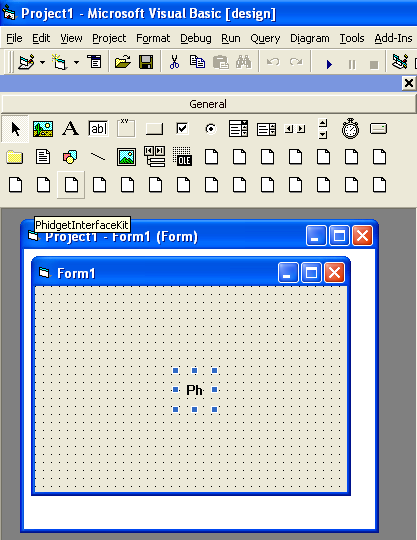
Alternatively, you can dynamically create the Phidget ActiveX object in code. For example, for an PhidgetInterfaceKit, you would type:
Dim WithEvents PhidgetInterfaceKit As PhidgetInterfaceKit
Private Sub Form_Load()
...
Set PhidgetInterfaceKit = Controls.Add("Phidget21COM.PhidgetInterfaceKit", "PhidgetInterfaceKit")
...
End Sub
The object name for each type of Phidget is listed in the COM API Manual. Please see the examples on how to add a reference to your particular Phidget.
The project now has access to the Phidget function calls and you are ready to begin coding.
The same teaching section which describes the examples also has further resources for programming your Phidget.
Follow the Examples
By following the instructions for your operating system and compiler above, you probably now have a working example and want to understand it better so you can change it to do what you want. This teaching section has resources for you to learn from the examples and write your own.
Next comes our API information, with syntax for all of our functions:
- COM API Manual (This is the complete set of functions you have available for all Phidgets)
- Device Specific APIs - The one for your Phidget can be found in its user guide.
To learn the details behind opening, configuring, using, and closing your Phidget, try the General Phidget Programming page. That page also describes using the Phidget in an event-driven manner and in a traditional manner, both of which are available in Visual Basic 6.0.
Example Flow
The Hello World example has this general structure so you can follow along. We also have an in-depth general introduction to writing Phidget code (like open, read data, etc), as well as the COM API Manual for specific syntax:
|
// ----- Event and Other Functions ----- Create any Language-Specific Functions (exception handling) Create General Attach, Detach, and Error Handling Functions:
|
In Visual Basic 6.0, you can name these event functions whatever you like. You will then pass them as function pointers to the Phidget library below in the Main Code section. This hooks them into the actual events when they occur. | |
|
// ----- Main Code -----
Close Device Delete Device
|
Creating a Phidget software object in Visual Basic 6.0 is specific to the Phidget. For a Phidget Spatial, for example, this would involve creating a PhidgetSpatial object. The examples show how to do this and other API functions |
Common Problems and Solutions/Workarounds
Known Issues:
Phidgets do not always work cleanly in Labview. Sometimes they do not appear, sometimes they work veeerrryyy slowly. No known fixes yet, hopefully soon.
